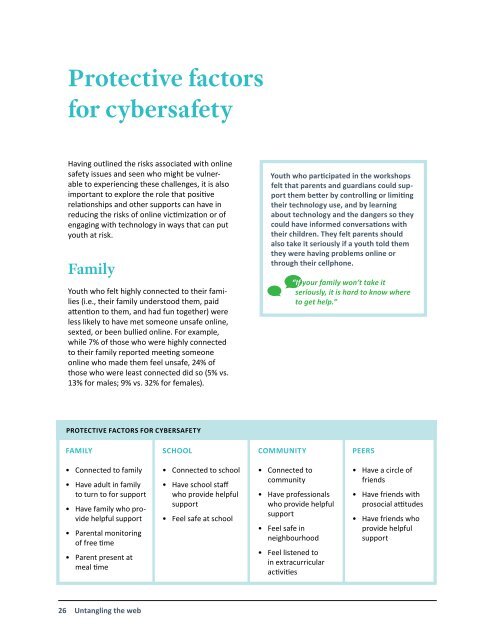Untangling the web
XRyQp
XRyQp
Create successful ePaper yourself
Turn your PDF publications into a flip-book with our unique Google optimized e-Paper software.
Protective factors<br />
for cybersafety<br />
Having outlined <strong>the</strong> risks associated with online<br />
safety issues and seen who might be vulnerable<br />
to experiencing <strong>the</strong>se challenges, it is also<br />
important to explore <strong>the</strong> role that positive<br />
relationships and o<strong>the</strong>r supports can have in<br />
reducing <strong>the</strong> risks of online victimization or of<br />
engaging with technology in ways that can put<br />
youth at risk.<br />
Family<br />
Youth who felt highly connected to <strong>the</strong>ir families<br />
(i.e., <strong>the</strong>ir family understood <strong>the</strong>m, paid<br />
attention to <strong>the</strong>m, and had fun toge<strong>the</strong>r) were<br />
less likely to have met someone unsafe online,<br />
sexted, or been bullied online. For example,<br />
while 7% of those who were highly connected<br />
to <strong>the</strong>ir family reported meeting someone<br />
online who made <strong>the</strong>m feel unsafe, 24% of<br />
those who were least connected did so (5% vs.<br />
13% for males; 9% vs. 32% for females).<br />
Youth who participated in <strong>the</strong> workshops<br />
felt that parents and guardians could support<br />
<strong>the</strong>m better by controlling or limiting<br />
<strong>the</strong>ir technology use, and by learning<br />
about technology and <strong>the</strong> dangers so <strong>the</strong>y<br />
could have informed conversations with<br />
<strong>the</strong>ir children. They felt parents should<br />
also take it seriously if a youth told <strong>the</strong>m<br />
<strong>the</strong>y were having problems online or<br />
through <strong>the</strong>ir cellphone.<br />
“If your family won’t take it<br />
seriously, it is hard to know where<br />
to get help.”<br />
Protective Factors for cybersafety<br />
Family<br />
School<br />
Community<br />
Peers<br />
• Connected to family<br />
• Have adult in family<br />
to turn to for support<br />
• Have family who provide<br />
helpful support<br />
• Parental monitoring<br />
of free time<br />
• Parent present at<br />
meal time<br />
• Connected to school<br />
• Have school staff<br />
who provide helpful<br />
support<br />
• Feel safe at school<br />
• Connected to<br />
community<br />
• Have professionals<br />
who provide helpful<br />
support<br />
• Feel safe in<br />
neighbourhood<br />
• Feel listened to<br />
in extracurricular<br />
activities<br />
• Have a circle of<br />
friends<br />
• Have friends with<br />
prosocial attitudes<br />
• Have friends who<br />
provide helpful<br />
support<br />
26 <strong>Untangling</strong> <strong>the</strong> <strong>web</strong>


